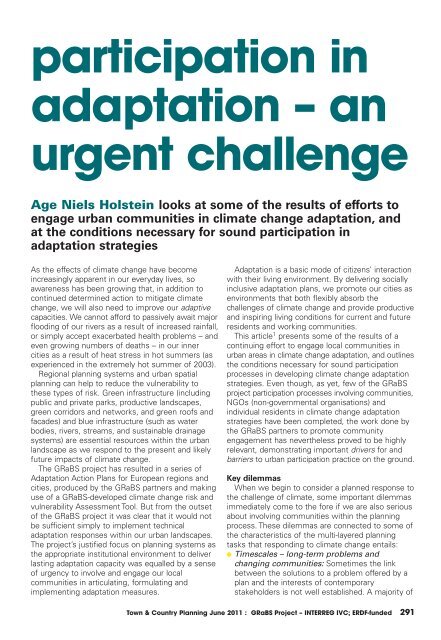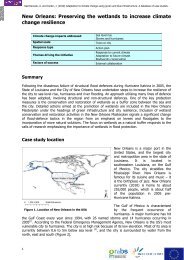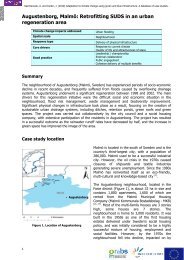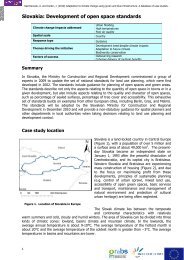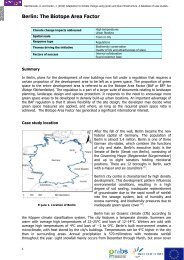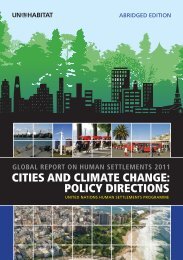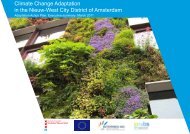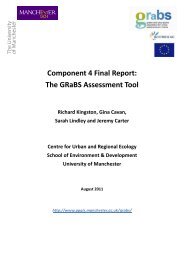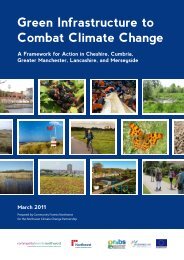Download - GRaBS
Download - GRaBS
Download - GRaBS
Create successful ePaper yourself
Turn your PDF publications into a flip-book with our unique Google optimized e-Paper software.
participation in<br />
adaptation – an<br />
urgent challenge<br />
Age Niels Holstein looks at some of the results of efforts to<br />
engage urban communities in climate change adaptation, and<br />
at the conditions necessary for sound participation in<br />
adaptation strategies<br />
As the effects of climate change have become<br />
increasingly apparent in our everyday lives, so<br />
awareness has been growing that, in addition to<br />
continued determined action to mitigate climate<br />
change, we will also need to improve our adaptive<br />
capacities. We cannot afford to passively await major<br />
flooding of our rivers as a result of increased rainfall,<br />
or simply accept exacerbated health problems – and<br />
even growing numbers of deaths – in our inner<br />
cities as a result of heat stress in hot summers (as<br />
experienced in the extremely hot summer of 2003).<br />
Regional planning systems and urban spatial<br />
planning can help to reduce the vulnerability to<br />
these types of risk. Green infrastructure (including<br />
public and private parks, productive landscapes,<br />
green corridors and networks, and green roofs and<br />
facades) and blue infrastructure (such as water<br />
bodies, rivers, streams, and sustainable drainage<br />
systems) are essential resources within the urban<br />
landscape as we respond to the present and likely<br />
future impacts of climate change.<br />
The <strong>GRaBS</strong> project has resulted in a series of<br />
Adaptation Action Plans for European regions and<br />
cities, produced by the <strong>GRaBS</strong> partners and making<br />
use of a <strong>GRaBS</strong>-developed climate change risk and<br />
vulnerability Assessment Tool. But from the outset<br />
of the <strong>GRaBS</strong> project it was clear that it would not<br />
be sufficient simply to implement technical<br />
adaptation responses within our urban landscapes.<br />
The project’s justified focus on planning systems as<br />
the appropriate institutional environment to deliver<br />
lasting adaptation capacity was equalled by a sense<br />
of urgency to involve and engage our local<br />
communities in articulating, formulating and<br />
implementing adaptation measures.<br />
Adaptation is a basic mode of citizens’ interaction<br />
with their living environment. By delivering socially<br />
inclusive adaptation plans, we promote our cities as<br />
environments that both flexibly absorb the<br />
challenges of climate change and provide productive<br />
and inspiring living conditions for current and future<br />
residents and working communities.<br />
This article 1 presents some of the results of a<br />
continuing effort to engage local communities in<br />
urban areas in climate change adaptation, and outlines<br />
the conditions necessary for sound participation<br />
processes in developing climate change adaptation<br />
strategies. Even though, as yet, few of the <strong>GRaBS</strong><br />
project participation processes involving communities,<br />
NGOs (non-governmental organisations) and<br />
individual residents in climate change adaptation<br />
strategies have been completed, the work done by<br />
the <strong>GRaBS</strong> partners to promote community<br />
engagement has nevertheless proved to be highly<br />
relevant, demonstrating important drivers for and<br />
barriers to urban participation practice on the ground.<br />
Key dilemmas<br />
When we begin to consider a planned response to<br />
the challenge of climate, some important dilemmas<br />
immediately come to the fore if we are also serious<br />
about involving communities within the planning<br />
process. These dilemmas are connected to some of<br />
the characteristics of the multi-layered planning<br />
tasks that responding to climate change entails:<br />
● Timescales – long-term problems and<br />
changing communities: Sometimes the link<br />
between the solutions to a problem offered by a<br />
plan and the interests of contemporary<br />
stakeholders is not well established. A majority of<br />
Town & Country Planning June 2011 : <strong>GRaBS</strong> Project – INTERREG IVC; ERDF-funded 291


